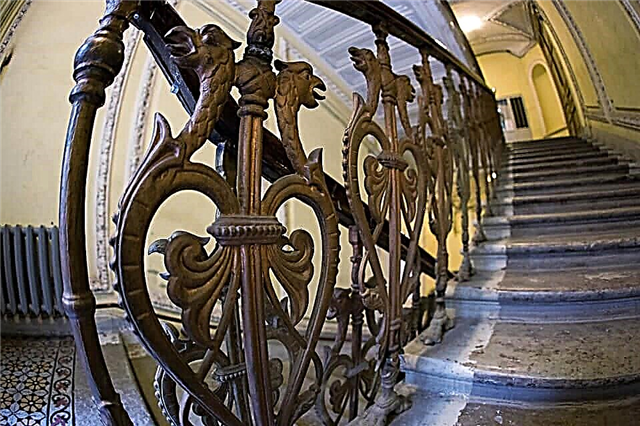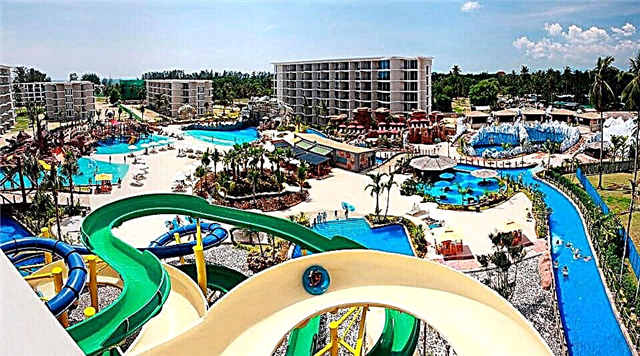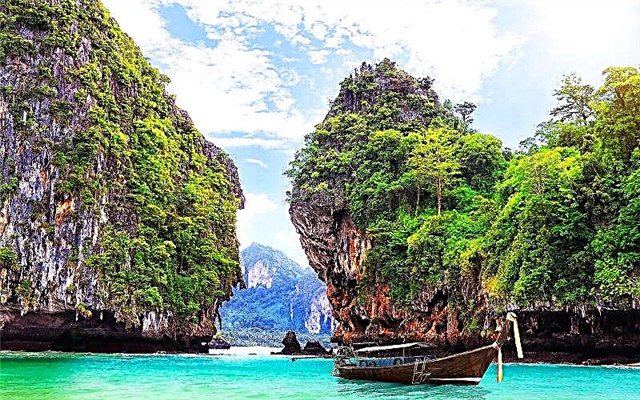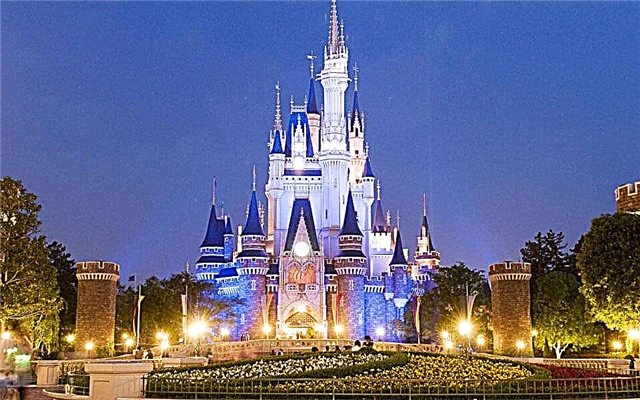The tranquil beauty and millennial culture of the Land of the Rising Sun attracts tourists from all over the world. Architectural monuments with centuries of history and modern buildings amaze with their unique beauty and deep meaning. The sights of Japan are a huge cultural heritage and the latest technologies that have surpassed time and made this country a world leader. Traveling around the Japanese islands, you will gradually, step by step, plunge into the enchanting world of the real East. Unique landscapes of chaste nature, rich traditions, high scientific potential - in whatever direction a tourist-traveler shows interest, there are many unique, exciting, sophisticated in Japanese. Let's get acquainted in these small notes with the most striking sights that you simply cannot fail to see when visiting this country.
Chureito Pagoda

This pagoda was built in 1958 in memory of the inhabitants of the city who died in wars over the past hundred years. The memorial complex is made in the traditional Japanese style and fits very organically into the natural landscape. From the hill on which the pagoda is located, there is an excellent view of Mount Fujiyama. Experts recommend admiring this view in the early morning - at this time the mountain is well lit. It is beautiful near the Chureito Pagoda in spring, when sakura blooms around and in autumn - in the scarlet flame of maples specially planted around this place.
To enjoy the beauty of the surrounding nature from the viewing platforms of the pagoda, you will have to climb to a considerable height. The road consists of 398 steps. This number is not accidental - 3,9,8 sounds like sa-ku-ya in Japanese. This combination is consonant with the name of the goddess of Mount Fuji - Konohana Sakuya. It's so Japanese - there is a deep meaning in everything.
This pagoda cannot boast of its ancient origins, but its sophisticated beauty has already become part of the traditional Japanese landscape. It is difficult to imagine a better landscape near Mount Fuji than the one depicted on all postcards now - with the red Chureito Pagoda.
Fujiyama volcano

The island of Honshu is famous for the fact that there is a visiting card of Japan - Mount Fujiyama. The name of the volcano is translated in different ways: as "untold wealth" or "noble man." The place is very revered by the locals, because for adherents of Buddhism and Shintoism it is sacred. According to ancient beliefs, Mount Fujiyama is a sacred habitat for the souls of deceased ancestors.
The mountain is the highest elevation in the country, reaching 3,776 meters above sea level. It has a regular conical shape, which was formed due to the long eruptions of several volcanoes. The peak, covered with snow, fits perfectly into the local landscape, giving it a unique beauty and laconicism.
The area around the mountain is preserved in its original form; the National Park is spread here. Despite the fact that the volcano is considered active, scientists believe that there is no threat of new eruptions yet. It is a dormant volcano that last showed signs of activity in 1708.
Kegon Falls

Nikko National Park presents travelers with a unique natural attraction - the most beautiful Japanese waterfall Kegon. Water seeps through the volcanic rock and falls from a height of 97 meters. The main waterfall is seven meters wide, but it is complemented by many more small waterfalls located on the sides. This is one of the three most famous waterfalls in the country and is often depicted on postcards with views of Japan, as well as on paintings.
This place is especially beautiful in autumn, when the foliage of the surrounding trees is painted in the brightest tones of wilting - from yellow-lemon to purple-burgundy. The beauty of the waterfall leaves no one indifferent. It can be clearly seen not only from specially equipped sites (some of which are paid), but also from the highway. At this point, many drivers slow down to enjoy the timeless beauty of Kegon Falls.
Tragic pages are also associated with this place: the waterfall attracts suicides to settle their last accounts with their lives. The first such tragic incident occurred in 1903 (Misao Fujimura died at the age of 17).
Nachi waterfall

This object occupies a special place among the unique natural attractions. It is not just the largest waterfall, which starts at 133 meters high and falls into a deep 10-meter bowl. This is a sacred place, where pilgrimage crossings are constantly made, part of the "Sacred place and pilgrimage trail in the mountains of Kii". The first Japanese emperors, steadfastly overcoming all the difficulties of a three hundred kilometer journey, came here to perform prayers. Nowadays, this path is recognized as a UNESCO World Heritage Site.
Near the waterfall, the Kumano Nachi-Taisha shrines were built, which could be visited by everyone who needed to turn to the gods, without any restrictions (unlike other mountain temples that prohibit entry to their territory for disabled people, women, etc.). The waterfall is an integral part of the holy place, it bestows peace. For thousands of years, the Japanese believed that its water and even a small spray can give health and renewal, that even a person rejected by society can be "born again" here and live their future life more happily.
Sagano Bamboo Forest
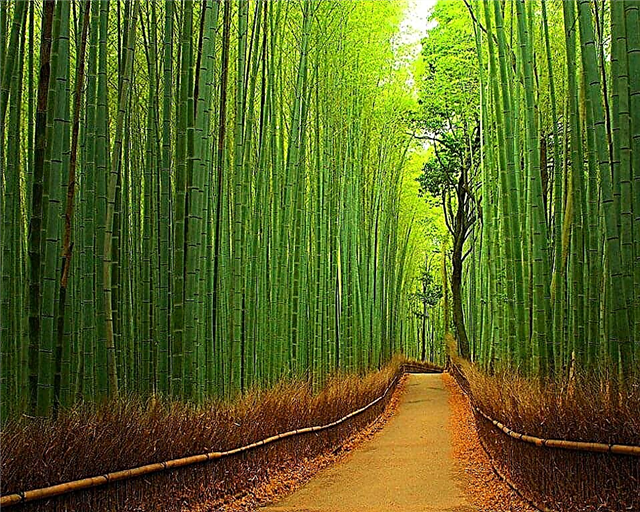
In the southwest of Japan, there is a rare natural landmark - a grove of evergreen bamboo. It spreads over an area of sixteen square kilometers within the city of Kyoto (on its western outskirts) and is surrounded by a standard urban landscape. The unique bamboo forest consists of thousands of very tall bamboo stalks that sway from the slightest breath of wind and “sing”, emitting a gentle sound, like the traditional oriental decorations - wind chimes.
This reserve has a long history - it arose on the site of an old park, which was built in the 14th century during the reign of Muso Soseki to contemplate the unique beauty of mountain landscapes and temple complexes. Which are perfectly visible from this area.
The bamboo grove is well equipped - there are special illuminated paths, suspension bridges. It is interesting to walk in this forest not only during the day, but also at night - tall trees cast long shadows, illuminated paths go to infinity, creating a unique atmosphere.
Kawachi Fuji Garden

The small town of Kitakyushu is famous for the most beautiful garden of flowers in the country - Kawachi Fuji. Its main attraction, the Wisteria Tunnel, is visited not only by the Japanese, but also by guests from all over the world. Various flowering plants grow in the garden. But the dominant is wisteria, which in Japanese is called "fuji". This flower is one of the symbols of the Land of the Rising Sun. Wisteria grows for a long time.
The plant gradually turns into a weaving tree with bizarre trunk shapes and a huge flowering crown, which must necessarily rest on a stable base - a building or special arched structures. Wisteria flowers are collected in bunches, resembling small multi-colored butterflies. They are surprisingly tender and fragrant, which makes them similar to our European acacia. Kawachi Fuji Park is designed in such a way that visitors are simply "immersed" in a flower paradise created by colorful tunnels of blooming wisteria. Flower corridors are named according to the color of wisteria: yellow, white, green, lilac, etc.
Hitachi seaside park

The park, beloved by all Japanese, was built recently.About thirty years ago, an American military base was located on this site. Now a huge area of 190 hectares, located within the boundaries of the city of Hitatinaka (in the east of the island of Honshu), has been turned into a resting place for the townspeople. In addition to flowers, there are other entertainments on the territory - a Ferris wheel, a swimming pool, amusement rides, bike paths.
But the park received worldwide recognition precisely because of its unique fauna: since March, millions of daffodils begin to bloom here, which replace about two hundred species of tulips, hyacinths, lilies and other luxurious flowers. An unforgettable impression on visitors is made by the gentle blue waves of blooming nemophila. In the summer, there is even a special festival called "Blooming nemophila" dedicated to this beautiful plant.
The open spaces planted with the kochia plant, which looks like a spherical bush, look unusual. It is planted in long rows, which change its color over time: in early spring the kochia is bright green, then the bushes brighten, lose their brightness. the color gradually turns into a calmer and warmer tone, and in the fall it acquires a bright red color.
River in Kawagoya

Kawagoe is a cultural and historical monument that immerses the traveler in the atmosphere of the 17th century. This city has a special status - the city of river crossing was once the main road along which goods were delivered to the capital of Japan, the city of Ego (today's Tokyo). The Sangashi-gawa river path and the Kawagoe-kaido treatise are transport arteries that have allowed the quiet and small town to raise its prosperity.
In the 17th century, the village was an impregnable fortress located on the banks of the river. Here merchants could safely store their goods, because special warehouses with thick clay walls - karazukuri - were built for their storage. Now the river channels are a great route for travelers who want to immerse themselves in the atmosphere of those distant times.
The city today is no longer as important to the supply of Tokyo as it was in the old days, but remains an important transportation hub. Now the city is more attractive as a cultural heritage and one of the most visited places by tourists.
Nakasendo road

In the 17th century, the cities of Kyoto and Edo (modern Tokyo) were connected by a treatise that passed through the mountain passes. It was called that - a road through the mountains. This path was used by traders, military men, local feudal lords and historical figures - so now the road is interesting for tourists who want to feel the spirit of that distant time. Hiking tours usually start in the city of Kyoto. The trek lasts ten days, during which you can see many interesting places, for example, such unique Japanese villages as Magome and Tsumago.
This feudal road is one of five hiking tourist routes, which acquaints the traveler in great detail with the history, life, and peculiarities of Japanese culture. On the way you will meet charming Japanese villages, ryokans (traditional Japanese hotels). During the ten-day trip from Kyoto to Tokyo, there will be unique Japanese landscapes with mountains and valleys around. The hike will be interesting, but it requires a certain physical form - on the way there will be descents and ascents, and other difficulties that you will have to overcome on your own.
Aogashima Island

The most beautiful island, which owes its origin to volcanic activity, is now inhabited by a small number of inhabitants. Not so long ago - at the end of the 18th century - Aogashima volcano revived, seismic activity began, the consequences of which were difficult to predict, and this posed a great threat to the local population. All residents were evacuated to safer areas in Japan. Only 50 years later, people came to the island again and began to engage in fishing and agricultural activities.
The climate in this place is subtropical, the island-volcano attracts tourists with its inaccessibility - it has only one harbor, the possibility of privacy, as well as beautiful landscapes. At the highest point of the island, there is an internal volcano crater. From here you can see the whole island, covered with bright vegetation and inhabited by a large number of birds. It is not always crowded here, but interesting. A little more than two hundred people live on the island, there is a small school, and all the infrastructure necessary for a normal life.
Shirakawa

Once this area was almost cut off from the outside world by impassable mountain paths. It is simply not possible to get to the village of Sarakawa on horseback. That is why a distinctive way of life and an original architectural style has developed here, which is now recognized as a world heritage and is protected by UNESCO.
The ancient buildings "gassho-zuruki" are of great interest to modern tourists. These are wooden residential buildings that are more than 200 years old. They are quite spacious, large, have several floors, and are unique in that they were built without a single nail, covered with thatch and have no chimney. Only the first floor is inhabited; on the rest, household operations are performed, for example, silkworm pupae mature.
The smoke that goes directly into the house provides protection against microorganisms and bacteria. He warms up the straw covering the gassho-zuruki. This architectural style is called “hands folded in prayer” because the roof really looks like the shape of a Buddhist monk's hands folded in prayer.
Kusatsu Onsen hot springs

The resort town of Kusatsu, which is located at Mount Kusatsu-Shirane-san, is world famous for its springs. Hot water comes out from the ground, which has specific properties. Locals have used this healing water for a long time to restore health. For the first time, the healing properties of local thermal waters were officially confirmed by the German physician Baelz back in the 19th century.
Moreover, the mineral composition of water in different springs is not the same. Therefore, the water in them has different properties, it can cure a very wide range of diseases. Manza Onsen is a unique thermal water of its kind, which has an unusual milky white color due to impurities. This spring is considered one of the most powerful, as its water is of the highest quality.
In the center of the city there is a powerful source of thermal water - Yubatake. About 4,000 liters of water bursts out of the ground, enveloping nearby buildings in thick steam during the cold season. At the top of Mount Kusatsu-Shirane-san is the emerald Yugama Lake. In winter, there are only hiking trips to the lake.
Jikogudani Snow Monkey Park

The forestland, located in the Dzikogudani flat area, is the natural habitat of Japanese macaques. These intelligent animals are also called "snow monkeys". Not far from this place are the cities of Sibu and Yudanaka. This valley got the name Dzigokudani, which means "hellish valley", because of the constant volcanic activity. There are many hot springs, and the Korakukan Ryokan can be seen on the way to the Snow Monkey Park.
It is most interesting to watch the animals in winter, when it snows. The location has an artificial pond where monkeys love to swim. If they do not want to go into the water, workers throw treats into the water, for which they immediately dive. Macaques, although they live in their natural environment, are already accustomed to people.
They are not at all afraid of visitors, they can let you in a very close distance. The life of the monkey community is under video surveillance around the clock, it is strictly forbidden to feed and disturb them. Information about the life of monkeys is presented in Japanese, and in an abbreviated form in English.
Sakurajima volcano

This natural landmark attracts tourists with what is now an active volcano.Sakurajima is a volcano that has repeatedly emitted significant emissions of ash and volcanic rocks, and, it seems, is not going to fall asleep in the near future. The last time an eruption (ash emissions) was in 1916. Then the pony government rated the seismic hazard at 2-3 points. The volcano before the eruption of 1914 was a separate island, which could only be reached by ferry. The overland route became possible when frozen lava connected the volcano island with the Osumi Peninsula.
Stepping on the ground around Sakurajima volcano, you can feel the warmth that comes from its bowels. If you dig a small hole, it will fill with warm water, which is nice to bask in. Tourists specifically purchase shovels for this procedure along with other beach accessories. The unique climate of this place allows for the cultivation of the largest daikon radish and very sweet mini tangerines.
Aokigahara

Mount Fuji has an unusual park. It is also called "the forest of suicides", since more than one terrible tragedy has played out on its territory. One of the true, not fictional stories of the twentieth century is the facts of starvation of old people whom relatives brought into the thicket and left here to die. This blood-chilling tradition of the Japanese has been described more than once in literary works, more than one film has been shot on this topic, so many travelers are very interested in seeing this wild and frightening thicket with their own eyes.

Moreover, according to statistics, up to a hundred suicides are found annually in the forest, who could not stand the modern rhythm of life, everyday troubles, problems with work and took their own lives. Tourists walk in specially equipped places, along paved paths. As a rule, no one is in a hurry to deviate from the route, so as not to accidentally find another suicide. The rescue service is always on the alert here - at the first signal from local residents who know how to distinguish between suicidal individuals, they rush to help.
Himeji Castle

Japan in the feudal period was enriched with luxurious castles, which were built to strengthen their power by local nobles. Nowadays, about 50 castles have survived on the Japanese islands, among which Himeji Castle, Nijo Castle, Matsumoto Castle occupy a special place. Himeji Castle or White Heron Castle is the most beautiful object, which with its style, graceful lines really resembles this bird. This is not a single building, but a complex of wooden buildings, of which there are more than 82.
Nijo Castle
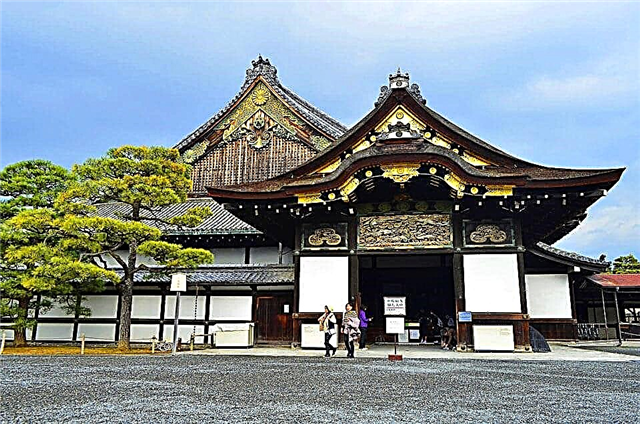
Nijo Castle is the seat of the Japanese rulers of Tokunawa. The dynasty has been in power for over 260 years. This object amazes with the power, size and sophistication of decorative ornaments. Inside the palace there are works of art, which are rightfully considered masterpieces of world art.
Karasu-jo castle

Karasu-jo Castle or Crow Castle bears its name due to the black color of the fortifications and the shape of the structures, which look like a bird spreading its wings against the wind. This castle has an unusual "nightingale floor", which was made so that it squeaks at the slightest touch. This was an additional security measure - the guards heard any rustle and could promptly stop the intruder.
Kumamoto Castle

The grandiose ancient Kumamoto Castle is located in the city of the same name in Kumamoto Prefecture. This magnificent structure is also commonly known as the "raven castle". The site is one of Japan's recognized national treasures. Initially, the castle was built as a small fort, an ordinary fortification. Its history dates back to the end of the 15th century. The founder of this fort was Idevo Hidenobu. Later, the building was rebuilt and transformed again, the castle served as the residence of the daimyo Kumamoto Khan for more than three centuries.
In the XX century, the castle was completely restored and restored. Currently serves as a museum-monument of Japanese castle architecture of the Edo period. On the territory of the castle-museum there is an exposition of medieval clothing and weapons, unique armor of samurai of those ancient times is kept. The attraction is located right in the city center, it can be reached in just ten minutes from the Kumamomto station by public transport or by walking, no more than 40-45 minutes long.
Kinkaku-ji

The "Golden Pavilion" Kinkau-ji is a Buddhist monastery that belongs to the Rinzai sect in Japan. This monastery is located in Kyoto, and has a monastery title - North Mountain, and the official name - Rowon Monastery. The complex is named "Golden Pavilion" because of the main building, the walls of which seem to have been erected from pure gold. The complex is part of the UNESCO World Heritage List.
This religious building was founded at the end of the VIX century, and its main shrine is the statue of the Bodhisattvi Kannon. The "Golden Pavilion" contains a valuable cultural monument - a portrait of shogun Ashikagi Yomitsu (previously the building was his residence and was reorganized into a monastery after his death), the monastery also contains frescoes from Daisho's office, and a refined monastery garden is laid out on the territory.
During the civil war in the second half of the 15th century, almost all the buildings of the complex were destroyed, with the exception of the "Golden Pavilion", this building was damaged by fire in 1950 and was restored over a long 48 years.
Hiroshima Peace Memorial

There is an interesting attraction in Nakazjima - the famous Peace Memorial Park. This complex was erected in memory of the tragedy that happened in 1945 - then the bombing of Japanese cities with nuclear weapons took place. The memorial museum is located on an area of more than twelve hectares; here you can see many monuments, ritual places, cenotaphs. The project was developed by renowned world-class architect Kezo Tange and his three colleagues.
In the park, you can see a memorial to the memory of a little girl who was half a kilometer from the epicenter of the explosion and died ten years after the tragedy from radiation sickness, her name was Sadako Sasaki. A story about 1000 paper cranes is associated with this girl's name. Another equally famous monument of the complex is the "Flame of Peace", a commemorative fire has been burning here since August 1, 1964, the flame will remind of the tragedy and its victims, as long as there will be a terrible atomic weapon on Earth. On the other side of the Ota River, you can see the Gembaku dome - a building that could survive after a bomb explosion.
Itsukushima Shrine

Many places and structures in the Land of the Rising Sun belong to the UNESCO World Heritage Site, one of them is the Itsukushima Shinto shrine in Hiroshima Prefecture. Some of the buildings in the complex and its properties are considered national treasures by the Japanese government. This place can often be seen on travel blogs, in the press or in movies. The ritual red gate of the sanctuary, which stands above the water, is one of the most recognizable panoramas in the country. Sometimes the complex is called a "sanctuary or temple on the water."
The temple complex consists of seventeen wooden buildings, it was previously believed that it was impossible to build on the land of the gods, and therefore the sanctuaries were erected on stilts above the water surface. There is a popular tradition among the guests of the complex - to leave coins in the gates to make a wish come true. This simple ritual can be done at low tide, when the bottom is exposed and you can freely walk to the gates of the temple.
The complex makes the greatest impression in autumn, at this time the surroundings of the complex are painted in all shades of yellow, gold and red, this creates an indescribable atmosphere. Every day people from different parts of the world come here to see the local sunset.
Nagoya Castle

In the Aichi Prefecture in the city of Nagoya, the majestic "Golden Castle" was erected at the beginning of the 17th century. At first, the castle served as a "family nest" for the Ovarian branch of the Shonun Tokugawa clan.Before the appearance of "skyscrapers", this building with golden decorations on the roof was striking in its grandeur. This beautiful structure could be seen from a distance of several kilometers. The Golden Castle is a striking monument of Japanese architecture. It is valuable as a historical object: from an aesthetic and military point of view.
Until the end of the 19th century, this place was the political and administrative center of the surrounding lands. Until 1945, the castle was a national treasure of the country, however, as a result of air raids by the US army, it was destroyed. In the restoration of the castle after the war, not only the government and international organizations took part, but also ordinary residents of the city of Nagoya. Now the "Golden Castle of Nagoya" is a museum and a symbol of the city, part of the historical heritage of the Japanese. The complex is constantly being renovated.
Tokyo Disneyland

On the coast of Tokyo Bay, you should definitely visit Tokyo Disneyland. Located in Chiba Prefecture, Urayasu City. An amusement park has been spread over an area of 80 hectares since 1983. There are 47 attractions here, this particular park was the first to be created outside the United States. In 2001, the satellite park "Tokyo Disney" was opened - a complex of water attractions. The park was refurbished after the 2011 disaster and is now better known as the Tokyo Disney Resort.
The territory is divided into seven parts with their own themes. Family hotels are nearby. The entire area is filled with themed shops, shaped like a suitcase. Interestingly, Tokyo Disneyland and its satellite park are the only Disney parks not owned by the Disney corporation.

Children under 3 can visit the amusement park free of charge, older children and adults will need to pay for the so-called "Disneyland passport", this document gives the right to visit all the offered attractions and entertainment.
Tokyo Tower

In the special area of Minato in Tokyo, the Tokyo Television Tower is more than 322 meters high. At the time of the completion of its construction, it received the world championship as the tallest steel object on the planet. The tower has a crumbly structure, its elements have an orange-white coating resistant to external influences, as prescribed by international aviation security standards. Today, the tower's antennas are broadcast by several Japanese television networks NHK, TBS and Fuji Television.
In addition to its immediate task - television broadcasting, the tower serves as an interesting tourist attraction, it is considered a symbol of Tokyo, along with other attractions. Several million tourists visit it annually to enjoy the panoramas from the observation platforms. Next to the tower is the administrative building, which houses a museum, restaurants and shops. Two observatories are also open for visiting on the territory. Very often, this giant tower can be seen as a location in Japanese and foreign films, TV series, and even in Japanese anime.
Kiyomizu-dera

Known as the Monastery of Pure Water, Kiyomizu-dera belongs to the Japanese Buddhist sect of Northern Hosso. This cultural monument is located, like many historically important buildings in Kyoto Prefecture, and has a monastic title - Mount Otova. The monastery got its name from the waterfall, which is located on its territory. Since 1994, it has been included in the UNESCO World Heritage List.
The monastery was founded back in the distant VIII century and its main shrine is the statue of a thousand-armed Cannock. Valuable monuments that are located on the territory of the monastery complex also include the golden temple, the gate of the guards, a three-tiered pagoda, and a bell tower. The modern central temple of the monastery is the "Main Hall", it is also called the "Kiyomizu Platform". It is considered a 10th century monument, however, it was significantly rebuilt in 1633. Among other ancient structures of the complex, the bell tower and the Western Gate stand out. Near these gates, a small street begins, on which shops and shops have been located since the 17th century.
Todai-ji Temple

The city of Naru annually attracts many pilgrims and tourists, because it is here that the most amazing Buddhist temple, Todai-ji, is located. Millions of Buddhist believers and curious tourists visit the shrine - the largest wooden structure in the world, which houses a huge statue of Buddha. The height of the statue is 14 m 70 cm. In addition to the Todaijirusyanabutsujo (Buddha) statue, Todai-ji has other unique attractions. For example, the temple gate, which is the largest in the country, or an impressive composition of several statues.
The Japanese are very careful about their shrine; it has been preserved in excellent condition for several centuries. In addition to this huge temple complex, the city has many other holy places - the total number of Buddhist temples reaches 525 pieces. These buildings are also wooden, but they are constantly carefully monitored so that negative natural factors do not destroy this heritage. The holy places of Naru, together with the Todai-ji Temple, are a true cultural heritage of the Japanese people.
Saiho-ji Moss Temple

The ancient capital of the Land of the Rising Sun - the city of Kyoto boasts an amazing attraction. This is a Buddhist temple, which not everyone can get to even now. 600 years ago, a monk-artist created a moss garden - Saiho-ji, which amazes with its unique beauty. About 130 species of mosses and lichens cover almost the entire territory, spreading not only to the soil, stones, but also to the trunks and roots of trees, bridges, giving the landscape a fantastic flavor.
The sun's rays pass through the dense foliage of the trees, illuminating the velvet mosses, and emphasizing their unusual texture with a rich color range (from emerald green to brown-brown and purple). The moss temple experienced different times: it was destroyed during feudal strife and rebuilt in 1339 by the famous Master Muso Kokushi.
The garden has several levels. In the lower one there is a pond similar to the hieroglyph "heart". It is also framed by a beautiful moss carpet. The man-made reservoir, which is filled with the "Pure Water" spring, has a poetic name - the Golden Pond.
Osaka castle
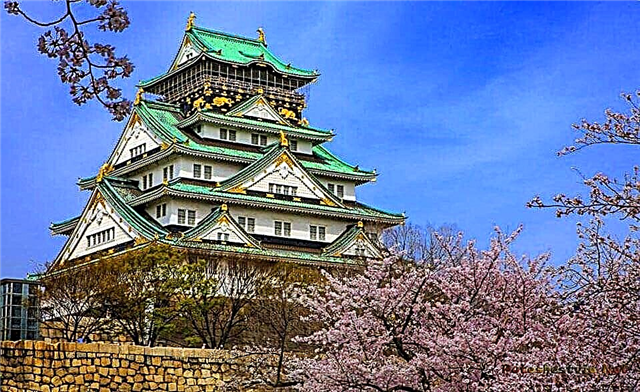
The castle, which surpasses all similar structures in Japan in terms of scope and area, has a rich history and special significance. He played an important role in uniting the country, and in 1597 was a unique, impregnable fortress. The history of the castle is rich and interesting; it experienced both victories and devastating defeats. It was restored several times, realizing the important historical role of this fortress.
Reconstruction and complete restoration of the castle was carried out in 1931. Since then, the building has housed a museum, which has collected various historical values and artifacts. The premises of the museum occupy a huge area - one square kilometer. The original decoration, which was completely destroyed over the past centuries, was not restored here, therefore the building was decorated in accordance with the requirements of museum organizations. There is a lift and other amenities for tourists. The original medieval interior of the Japanese castle has been restored at some of the ancient sites and can be viewed elsewhere in Japan.
Fushimi Inari Taisha Shrine

There are many temples in Japan dedicated to Inari, a particularly revered deity who protects rice, sake, tea, fertility, growers, and merchants. The most important of these temple structures and an interesting attraction is the ancient sanctuary in Kyoto. The temple is located on the Inari hill, and in order to get to it, you need to overcome a 4-kilometer climb up the steps.On the way, you can admire other small sanctuaries, of which there are many along the way.
The main attraction is the Fushimi Inari Taisha Temple located at 233 meters above sea level. Visitors experience a special feeling when they pass through the many bright red and black tori gates of this temple. Torii were donated by various businessmen, merchants, samurai. On the way to the temple, you can see the statues of kitsune foxes. They are considered the messengers of the cunning deities of the Inari. Kitsune are werewolves who, according to local beliefs, can infiltrate a person by leaking through the nail plates on the fingers.

